[ad_1]
What is a college course syllabus?
Before defining a college course syllabus template, it’s essential to clarify the definition of a college course syllabus itself. Essentially, a course syllabus for any academic program at any level contains all the necessary information about that class. This includes but is not limited to the topics to be covered, schedule, learning resources and a list of tests and assignments and their associated weightings. A good course syllabus should also provide clarity around learning outcomes as well as rules, expectations and pedagogical practices to guide students in their learning.
→ Download Now: 100% Customizable Class Syllabus Template [Free]
A syllabus includes four basic categories of information:
- Information about the instructor
- Course policies
- Required texts and supplies
- Schedule of classes and assignments
Why is a college course syllabus important?

In any college course, a syllabus is one of the initial points of contact between an educator and student. It serves as a central source of information about a course that all students can refer to anytime they have a question to ensure they receive the same uniform answer. The class syllabus can be referred to when building out your course administration—whether in Top Hat or another educational technology platform.
No matter what course you teach, the purpose of a syllabus remains the same. A course syllabus serves as a contract, a permanent record and a learning tool. The ideal course syllabus takes all three of those objectives into account in its crafting. Later on, we’ll explore the three purposes of class syllabi in depth.
A class syllabus template can help you make sure you have all necessary information listed around course policies, accommodation guidelines and assessments. Digital syllabus templates may additionally offer guidelines on how to write different sections with inclusivity in mind. Some universities also offer fun syllabus templates that offer tactics on making your course document approachable and appealing to Generation Z.
Who are the audiences for a college course syllabus?

When crafting a college course syllabus, it’s critical to keep in mind the audiences for that syllabus. While your students may be the primary focus, they are far from the only audience. You should also craft your course syllabus with colleagues and administrators at your school in mind.
The educator
A syllabus is important to you, the educator, because it helps you to map out how you’ll prepare for and spend each day of the program. It serves as a reminder of what’s coming up next and ensures you stay on track in meeting your course objectives. Giving students a comprehensive syllabus also frees up your time to focus on areas that require specialized attention, like developing lesson plans, grading papers and checking in with students on their progress.
The student
For students, a syllabus helps set them up for success by giving them all they need to know to excel in the class. The ideal syllabus is a student’s complete guide to a course. By reviewing the course syllabus closely, a student should be able to understand exactly what will be expected of them in the course.
Colleagues
Your syllabus is important to your colleagues in case any of them have to fill in for you during an absence. It can also help new instructors take over your role if you’re ever promoted or move on to a different job elsewhere. In addition, if there are other teachers teaching the same course as you in the school, comparing your syllabi against one another’s can help you ensure that each of you is providing students an equivalent educational experience regardless of whose classroom they’re in.
Administrators
For administrators, your syllabus helps them ensure that your course is consistent with the program in which it is a part, with the school’s expectations and teaching philosophy and with the larger standards of the state. Sometimes, complying with certain state standards in your course syllabus is necessary in order for your school or program to receive certain funding.
The two main groups that will likely rely on class syllabus templates the most are educators and administrators. Administrators may mandate their staff to use a particular syllabus template to ensure all students receive the same quality and course experience, no matter what year or discipline they’re in. Educators can also use simple syllabus templates to guide them in writing the various components of this essential course document.
What you can do with a free editable syllabus template

These course syllabus templates are completely editable, meaning that you can add, delete, alter and reshuffle any of the content to suit your specific needs.
Most syllabus templates aren’t meant to be copied and submitted to students as-is. Instead, each section provides prompts for useful information to include and the spaces to include it. It’s up to you to pick and choose which of that information to include and how to present it.
For the best use of these free editable syllabus templates, be sure to reflect yourself, your teaching philosophy and your own unique points of focus. Apply your own personality to your editable college syllabus template. Consider using it to give the students a sense of your teaching style. You can even create a fun syllabus template by making it colorful and visually interesting, if appropriate, by including images, GIFs, fun facts or interesting links.
Make sure your edited syllabus demonstrates empathy for the students’ process of learning through your course and respect for their time and learning challenges, particularly if you’re teaching a remote or blended course.
→ Download a 100 percent customizable syllabus template with easy-to-follow directions
What to include in a syllabus outline

A great deal of information goes into a typical college syllabus. The purpose of a syllabus is to give students a roadmap of what will be expected of them in your course, where to seek support and outlines what students should expect to learn by the end of your course. Our downloadable simple syllabus template includes the following sections and information—which will make your course syllabus easier to read.
- The basics: Including information about the college, department, term and course credit, course location, the teacher and any co-instructors along with their contact information and office hours. It may also include specific details like email etiquette for students, academic or school policies and, if applicable, a campus Indigenous land acknowledgment statement.
- Table of contents: A section clearly laying out the content and flow of the syllabus with hyperlinked entries to give students the quickest and easiest access to navigate the document.
- About the course: Contextual elements of the course, such as the official course description, objectives, pre-and post-requisites, required resources like textbooks, hardware and software (such as required technology tools and platforms), assignments and assessments overview, learning outcomes, collaboration expectations and activities and available tools and advice on how to be successful in the course.
- Course policies and expectations: Administrative elements of the course, such as its policies regarding attendance, participation and camera use, accommodations, computer and Internet access and plagiarism. You can also include a basic needs statement here to direct students who need basic food and housing assistance to the on-campus and external resources that can help them thrive.
- Attendance policy: How many sessions is a student permitted to miss and still pass the course? Is attendance taken each session and, if so, how will it be recorded? What must a student do if they’re going to be absent? How should they make up for any missed coursework? How does lateness affect a student’s grade, and what must a student do if they are going to be late for a session? If your course is asynchronous, how will attendance and participation be measured?
- Participation requirements: Similarly, how much are students expected to participate in the class and how much does this contribute to their grade? What degree of participation do you expect from each student, and what does this look like in practice? Does the course entail lab sessions, tutorials or seminars in which the students are required to participate? Is the course synchronous, asynchronous or blended, and how does that affect your participation expectations of students?
- Behavioral expectations: Outside of participation, how do you expect students to act and treat one another in class? If your course is online, what netiquette guidelines will you provide to your students?
- Academic integrity statement: This is a statement of your expectations and the rules and regulations regarding students’ academic performance in and out of class. If there are any academic prerequisites or corequisites associated with the course, outline them here. This may include not only prior coursework but previously acquired knowledge, skills or abilities you expect from students. This section can also clarify aspects of the course that may commonly confuse students. An important element to clarify is what counts as appropriate collaboration and the boundaries between acceptable paraphrasing and required citation.
- Personal support: For students requiring mental and emotional support, you may include a statement detailing support and services available to them through the school or local community.
- Course schedule or calendar: The final section of your college course syllabus should include a clear and detailed outline of the course schedule over the calendar term, including important deadlines and exam or assessment dates.
Differences among syllabi for different types of courses and learning
While all syllabi will contain some degree of each of the aforementioned elements, differences will necessarily exist between syllabi for different types of courses, such as online and offline, and different types of learning, such as synchronous and asynchronous.
Asynchronous vs. synchronous syllabi
A syllabus will differ depending on whether you’ll be conducting the course in a synchronous, asynchronous or blended format. It helps to understand the differences between these approaches.
- In synchronous learning, the students and teacher all meet together in the same place and time, even if that “place” is online, such as a video conference. Students access activities, resources and course content at a specified time and place. In some cases, students taught synchronously may still have some control over their pace. Students also have direct and immediate access to teachers and peer support while undertaking tasks and assignments.
Synchronous learning allows for greater class engagement, dynamic learning and educational depth. However, it imposes a rigid schedule and the possibility of certain logistical difficulties, such as access to a computer and reliable Internet.
- In asynchronous learning, students move through the coursework at their own pace. Students can access course materials and work on their studies from anywhere that offers an Internet connection. In some cases, students can even download coursework and materials in advance of their study time so they can work when and where a computer or Internet connection may be lacking.
Students are fully in charge of the time, place and pace of their learning and complete all tasks and assignments independently. Asynchronous learning allows for greater flexibility. However, it can also involve greater isolation and the potential for apathy and technical difficulties, such as computer software errors and Internet access issues.
- In blended learning, some of the coursework is conducted in real-time. Students and instructors meet at the same time and location to conduct some course activities. Other work is conducted on the student’s own time. An example of blended learning is low-residency programs. In these programs, students meet with teachers and each other on campus for a brief period at the start of each term. Then, they conduct their studies for the remainder of the term asynchronously at home on their own time.
Considering the differences between synchronous, asynchronous and blended learning, it’s easy to see how the syllabi for each should be different as well.
- For a synchronous course: The times and locations of each class session and exam will be strictly scheduled. Attendance, lateness and absence policies are typically detailed in the course policies section.
- For an asynchronous course: A greater focus is placed on due dates and deadlines. As long as a student reviews materials and completes assignments, exams and other assessments within the expected timeframe, they remain in good standing. Course policies for this type of course may place a greater focus on academic integrity than attendance and participation. A syllabus for asynchronous learning should also detail exactly how students will be assessed and what learning outcomes they should strive for.
- For a blended course: Synchronous and asynchronous elements of the course must each be delineated. While both elements must be scheduled, students need to be clear on which elements require real-time, in-person participation and which elements are merely deadlines and due dates. Course policies may focus strongly on participation, given the opportunities to do so will be limited.
Syllabus in virtual/online learning
As more coursework takes place virtually, it’s important to note some of the differences between online or blended courses.
For an online course schedule, be sure to include:
- Unit of time: Do you use a weekly time frame or more flexible modules to structure the course? If using a weekly time frame, consider making assignments due at the end of each weekly period. If using modules, incorporate regular check-ins or incremental due dates to maintain consistent contact with students and encourage progress.
- Weekly structure: On what days does each weekly period begin and end? This can help students better organize their time on each assignment and avoid lateness. It can also keep students from attempting to contact you during times you don’t wish to be contacted.
- Workload: Including a rough idea of how much time students are expected to commit to coursework each week can be extremely helpful for students working on their own. You may even include additional guidance on the degree of motivation and self-discipline necessary to succeed in the course.
- Type(s) of learning: Online courses can be synchronous, asynchronous or blended. Let students know in the online syllabus what type or types of learning will take place in the course and the procedures and expectations for each. How will classroom discussions take place, for example: in a scheduled real-time chat or over an asynchronous forum?
A syllabus for an online course may also include information on where and how students can obtain technical support and what software or services students should use to communicate with peers and instructors.
If students need to learn certain types of technology to be successful, set this expectation as well as any necessary guidance or resources. As with any course document, you should also include tips and advice on how to succeed in the course.
Frequently asked questions

What is a syllabus template used for?
If a course syllabus is a student’s guide to a course, a college syllabus template is a teacher’s guide to creating an effective syllabus. Rather than merely provide instructions, like a tutorial, a template provides prompts for certain specific information and gives you the spaces in which to enter it. Then, when it’s completed, the class syllabus template allows you to print out a ready-to-use course syllabus you can distribute immediately to your next group of students.
Some syllabus templates may already be pre-written for arts, STEM and social science courses. Contrastingly, you may be able to download a free editable syllabus template, which you can adapt to the needs of your course and students.
What are some well-designed examples of college course syllabi?
No matter how many students are in your next course or what subject matter you teach, well-designed syllabus examples can help your students feel motivated and supported from the very beginning of the semester. We share effective syllabus examples below for you to base your own syllabus around.
- The University of Nebraska-Lincoln’s course syllabus template clearly outlines the various parts of an effective syllabus, along with grading guidelines. Including a course calendar in your own syllabus can further make it easy for students to stay on track, while letting advanced students read ahead.
- The University of Wisconsin-Stevens Point’s college course syllabus template offers guidelines for writing the five major sections of any class syllabus: course information, course learning outcomes, topic outline/schedule, grading policy and course policies. This syllabus is an effective example since it also provides clear netiquette tips for any online class—which can be applied to any hybrid or blended course as well.
- The University of South Carolina Center for Teaching Excellence offers three free editable syllabus templates that are designed for face-to-face, online and blended courses. These syllabi examples outline how to write each section effectively, while the university also offers syllabus best practices for faculty. You’ll learn what pieces are essential to include on your next syllabus, no matter what modality you choose to teach in.
Tips for editing your syllabus template

Once you’ve completed a draft of your college syllabus template, try and read it through the eyes of your students. Imagine you know nothing about yourself or the course, and see if your syllabus gives you a clear and cogent idea of who you are, what the course is about, how it is structured, what the student will get out of it and why you are qualified to teach this course.
Be sure to include all pertinent details, but avoid rambling, repeating yourself or giving unnecessary information. As much as you want to prepare your students for success, you also don’t want to risk giving them information overload before the first day of class has begun.
Another powerful way to make sure your course syllabus is as good as it can be before disseminating it to students is to submit it to colleagues in your department for peer review. This certainly doesn’t take the place of your own meticulous self-review, but it can give you the benefits of a fresh, unbiased set of eyes. In particular, ask your chosen peer-reviewers to identify anything that may be confusing and any gaps that may need filling.
Use the following syllabus checklist for additional questions you can ask both in your self-review and peer-review of your course syllabus:
- Is the description of your course thorough enough to inform the reader of the value of the course content and the instructional methods to be applied?
- Are all the required materials, supplies, texts and prerequisites listed essential to the course, and do they each contribute to achieving the learning outcomes of the course?
- Have you included sufficient details about the structure of the course to distinguish it from other courses on similar subjects?
- Are the learning outcomes clearly described, and are they appropriate for student learning at that level?
- Are the assessment methods outlined clearly, and are they appropriate for student learning at that level?
- Have you identified the components and course activities that will run in person and online, both synchronous and asynchronous?
- Do students clearly know where to seek support when facing financial, socioeconomic or basic needs concerns?
Fun with syllabi
As long as it contains all the essential information, your syllabus doesn’t have to be stale and boring. Instructors far and wide have come up with different types of creative, innovative syllabi.
If you’re savvy with graphic design software, for example, you can create a graphical syllabus, also known as a ‘visual’ syllabus. This may include images, charts and graphs, like an infographic. Similarly, you can parse out the information you need to convey in bite-sized chunks by creating a PowerPoint document.
Some tips for an effective graphic syllabus:
- For a simple syllabus template, limit your choice of colors to just a few to keep the document from being too visually overwhelming.
- Keep the design relatively simple, avoiding clutter and allowing for plenty of space to maintain readability and flow. Avoid intricate, hi-res graphics, as well. Instead, use simpler line drawings and vector images.
- Use basic fonts, avoiding anything too fancy that may be hard for some to read.
- If your students will be downloading the document to print on their own, keep the document and pixel size to a reasonable level so accessing it doesn’t become prohibitive. Creating a syllabus template in Google Docs is a great way to ensure it is accessible for atudents.
Understanding how to develop a great syllabus means defining the roles and responsibilities of teacher and student alike and presenting a clear assertion of the course’s intended learning outcomes. Ideally, it should establish procedures and standards for assessment and apprise students of all logistics about the course. This, in turn, helps create a clear channel for communication between students and instructors.
Simple syllabus template (Free download)
This free, editable syllabus template is ready to use upon download and works as a Microsoft Word or Google Docs file. Simply open the class syllabus template in the corresponding program and begin entering in your responses to each of the prompts in the text boxes provided. It’s really as simple as that.
→ Download our free course syllabus template for teachers today
Conclusion
College students are expected to be more self-directed and accountable for their learning progress than students in preliminary and secondary educational programs and curriculums. College course syllabi must therefore be designed to facilitate this more self-directed style of learning. College students may also have greater demands on their time, so giving them a complete view of assignments, exam dates and deadlines to schedule into their calendars is particularly important in avoiding conflicts.
On a purely administrative level, a college course syllabus may also require more detailed information about the credits a student earns for completing the course and the exact times and locations on campus or virtually for any classes, conferences or labs.
Make your next class accessible, inclusive and effective by referring to our course syllabus template for teachers—downloadable for free.
[ad_2]

![How to Create a Simple Syllabus for Your College Classroom [+ Free Syllabus Template]| Top Hat](https://msgraduate.com/wp-content/uploads/2023/01/Syllabus-Template-Blog-Support-Post-750x375.jpg)
